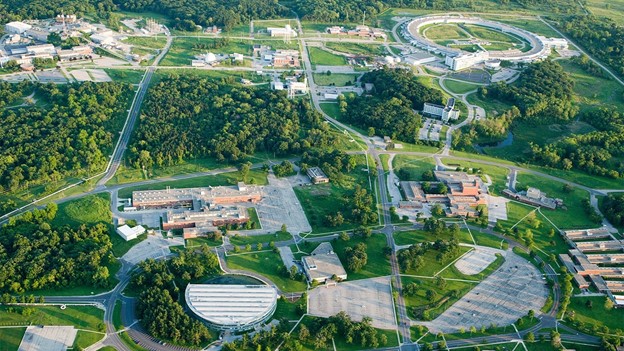Five leading researchers from the U.S. Department of Energy’s (DOE) Argonne National Laboratory have been recognized as Argonne Distinguished Fellows, the highest professional scientific rank accorded by the laboratory. The new fellows “have earned international recognition for their work and demonstrate the type of leadership that enables Argonne to accelerate science and technology for U.S. prosperity and security,” according to Argonne.
The distinguished fellows were named in a ceremony on October 29. Argonne Distinguished Fellows represent only three percent of research staff at the laboratory.
The five Argonne Distinguished Fellows for 2020 are Lin X. Chen, Julie Jastrow, Guy Savard, Deming Shu and Dileep Singh.
Lin X. Chen is senior chemist in Argonne’s Solar Energy Conversion group, Chemical Sciences and Engineering division. Chen is also a professor of Chemistry at Northwestern University. She received her Ph.D. from the University of Chicago. After her postdoctoral research at the University of California-Berkeley, she joined Argonne as a staff scientist in 1989.
While at Argonne, Chen conducted pioneering research in X-ray transient absorption spectroscopy and constructed one of the first such facilities at the Advanced Photon Source (APS), a DOE Office of Science User Facility at Argonne, to capture short-lived transient molecular structures of photoexcited states. In 2007, she joined Northwestern University as a full professor, where she expanded her overarching research in both institutions. Her research focuses on fundamental light-matter interactions, including excited-state molecular structural dynamics in photocatalytic and photovoltaic processes.
In recent years, she also has led research teams working on understanding the roles of ultrafast and coherent electronic and atomic motions in photochemical reactions, as well as functional structural dynamics of biomacromolecules on multiple spatial and temporal scales. Her main tools for research are ultrafast laser and X-ray spectroscopy/scattering and other property/structural methods in collaborations with theorists and chemists interpreting and making molecules and materials.
Chen was named one of the most highly cited scientists in 2019 by the Web of Science, with more than 240 publications, and more than 200 invited lectures. She was a member of the Research Council for the Chemical, Biological and Geological Sciences Division, Basic Energy Science, U.S. Department of Energy. She is an AAAS Fellow and has won the Experimental Physical Chemistry Award from the ACS Physical Chemistry Division in 2020. She also received the UChicago Argonne Board of Governors Distinguished Performance Award in 2002.
Julie Jastrow is a senior terrestrial ecologist and group leader of the Ecosystem Biogeochemistry group in Argonne’s Environmental Science division.
Jastrow is also a member of the Northwestern-Argonne Institute for Science and Engineering and the adjunct graduate faculty in the Department of Biological Sciences at Boise State University. She joined Argonne as a scientific assistant in 1975, transitioned to assistant scientist in 1979, and became a senior scientist in 2010.
Jastrow’s research interests include plant-microbe-soil interactions and the biological and physicochemical factors affecting soil organic matter dynamics, soil structure, terrestrial carbon sequestration, and restoration ecology. Currently, she is investigating the vulnerability of permafrost-region soils to environmental change and the climate adaption and sustainability of perennial bioenergy feedstocks.
Jastrow has served as president of the Soil Ecology Society and was chosen by the Soil Science Society of America to deliver the 15th Francis E. Clark Distinguished Lectureship on Soil Biology. She received the UChicago Argonne Board of Governors Distinguished Performance Award in 2014. She holds B.S. and M.S. degrees in agricultural science and agronomy from the University of Illinois at Urbana-Champaign and a Ph.D. in Biological Sciences from the University of Illinois at Chicago.
Guy Savard is a senior physicist in Argonne’s Physics division and director of the Argonne Tandem Linac Accelerator System (ATLAS) facility. ATLAS is a DOE Office of Science User Facility located at Argonne.
Savard’s current research centers around low-energy tests of the Standard Model of electroweak interaction. These studies are performed on samples of radioactive ions captured in ion traps, where they are available for high-precision experiments. New techniques developed by his group to efficiently capture short-lived isotopes of essentially any species caught in an ion trap allow them to select isotopes with decay properties which enhance and isolate specific effects and hence are especially useful for the physics of interest. Savard expanded the application of these ion manipulation techniques with the construction of the CARIBU upgrade to ATLAS that now provides unique neutron-rich beams for astrophysics and nuclear structure studies.
Deming Shu is a senior engineer in Argonne’s X-ray Science Division (XSD).
Shu’s research focuses on nanopositioning. His work involves high-precision optomechanical positioning instrumentation for synchrotron radiation applications, including X-ray optics systems for the APS. By developing new nanopositioning technologies for X-ray mirrors and other optical components, Shu’s work is paving the way for the APS Upgrade and a DOE-funded project to build a cavity-based X-ray free-electron laser.
Shu’s career at Argonne and the APS commenced in 1991 as Chief Design Engineer of the Beamline Engineering Group in the X‑ray Facilities division (now the X-ray Science Division, or XSD). He leads the Nanopositioning Support Laboratory. He is holder or co-holder of 20 U.S. patents. His previous honors include a 2009 R&D 100 Award (co‑recipient) for the Argonne hard X-ray nanoprobe, a 2016 R&D 100 Award (co-recipient) for the Brookhaven National Laboratory hard X-ray scanning microscope with multilayer Laue lens nanofocusing optics, and a 1999 Argonne/University of Chicago Distinguished Performance Award.
Dileep Singh is a senior materials scientist and group leader for Thermal and Structural Materials within the Applied Materials division at Argonne.
Singh is recognized for his scientific and engineering contributions in the research of materials for energy and environmental applications. His work combines materials design, innovative processing, advanced characterizations, and technology demonstration. His current research interests include manufacturing science and engineering of materials for harsh environments.
Singh has made several impactful contributions, including the development of a high-efficiency thermal energy storage system that can operate at temperatures over 700°C. This system has applications that include solar thermal plants, waste heat recovery, and thermal desalination. He is a co-inventor of a low-temperature phosphate ceramics technology, Ceramicrete, and his innovations have led to the use of phosphate ceramics for structural work, nuclear materials storage, and radioactive/hazardous waste disposal.
Singh is a Fellow of the American Society of Materials and the American Ceramic Society. His research has produced more than 170 peer-reviewed papers and 27 U.S. and international patents. He is a recipient of three R&D 100 awards and a Federal Laboratory Consortium award for technology transfer. Singh has a Ph.D. in materials science and engineering from the University of Utah and started his career as a postdoctoral fellow at Argonne in 1991.
“All of the Argonne Distinguished Fellows have, throughout their careers, made a lasting impact in their fields of expertise,” said Argonne Director Paul Kearns. “Their commitment and contributions are inspiring, and we appreciate their research and discoveries that accelerate U.S. prosperity and security.”
source: Jared Sagoff, Argonne




